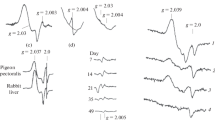Abstract
The decomposition studies of S-nitrosothiols (RSNO) are important due to their potential role in vivo in connection with the storage and transport of nitric oxide (•NO) within the body. Reactions of hydroxyl radicals (•OH) with a number of RSNOs (S-nitroso derivatives of N-acetyl-dl-penicillamine, l-cysteinemethylester, N-acetylcysteamine, and dl-penicillamine) in aqueous medium at neutral and acidic pH have been reported in the present study. Radiation chemical technique (steady state and pulse radiolysis) has been utilized for the determination of the reaction rate constants, the end product analyses, and the transient intermediate species. The rate constants for the reaction of •OH with the selected RSNOs were determined using a competition kinetic method with 2′-deoxy-d-ribose as the competitor. All the rate constants were found to be of the order of diffusion controlled (1010 M−1 s−1). The degradation yield of RSNOs was found to be quantitative (i.e., G(–RSNO) ≈ G(•OH)) at neutral and acidic pH. The major products of decomposition were the respective disulfide (RSSR) and nitrite (NO2 −). A good material balance is also obtained between the degradation yield and the formation of the products (i.e., G(–RSNO) ≈ G(RSSR) + G(NO2 −)). The major transient intermediate was the thiyl radical (RS•). Its intermediacy was confirmed by making use of the electron transfer reaction of 2,2′-azinobis(3-ethylbenzothiazoline-6-sulfonate) (ABTS2−) to RS•, which results in the formation of ABTS•− having a transient absorption spectrum with λmax at 410 nm. Based on these results, a generalized reaction mechanism is deduced for the reaction of •OH with RSNO.




Similar content being viewed by others
References
P.G. Wang, M. Xian, X. Tang, X. Wu, Z. Wen, T. Cai, A. Janczuk, J. Chem. Rev. 102, 1091–11343 (2002)
L. Liu, Y. Yan, M. Zeng, J. Zhang, M.A. Hanes, G. Ahearn, T.J. McMahon, T. Dickfeld, H.E. Marshall, L.G. Que, J.S. Stamler, Cell 116, 617–628 (2004)
D.L.H. Williams, Acc. Chem. Res. 32, 869–876 (1999)
D.L.H. Williams, Methods Enzymol. 268, 299–308 (1996)
A.F. Vanin, A.A. Papina, V.A. Serezhenkov, W.H. Koppenol, Nitric Oxide 10, 60–73 (2004)
V.R. Zhelyaskov, K.R. Gee, D.W. Godwin, Photchem. Photobiol. 67, 282–288 (1998)
P.D. Wood, B. Mutus, R.W. Redmond, Photchem. Photobiol. 64, 518–524 (1996)
V.M. Manoj, C.T. Aravindakumar, Chem. Commun. 2361–2362 (2000)
V.M. Manoj, C.T. Aravindakumar, Org. Biomol. Chem. 1, 1171–1175 (2003)
E. Ford, M.N. Hughes, P. Wardman, J. Biol. Chem. 277, 2430–2436 (2002)
V.M. Manoj, H. Mohan, U.K. Aravind, C.T. Aravindakumar, Free Rad. Biol. Med. 41, 1240–1246 (2006)
L.A. Peterson, T. Wagene, H. Sies, Chem. Res. Toxicol. 20, 721–723 (2007)
N.A. Stasko, T.H. Fischer, M.H. Schoenfisch, Biomacromolecules 9, 834–841 (2008)
L. Heikal, G.P. Martin, L.A. Dailey, Nitric Oxide Biol Chem 20, 157–165 (2009)
S. Aleryani, E. Milo, Y. Rose, P. Kostka, J. Biol. Chem. 273, 6041–6045 (1998)
T.W. Hart, Tetrahedron Lett. 26, 2013–2016 (1985)
J.M.C. Gutteridge, FEBS Lett. 128, 343–346 (1981)
S.N. Guha, P.N. Moorthy, K. Kishore, D.B. Naik, K.N. Rao, Proc. Indian Acad. Sci. Chem. Sci. 99, 261–271 (1987)
J.M. Joseph, T.L. Luke, U.K. Aravind, C.T. Aravindakumar, Water Environ. Res. 73, 243–247 (2001)
B.S. Wolfenden, R.L. Willson, J. Chem. Soc. Perkin Trans. 2, 805–812 (1982)
T.E. Eriksen, G. Fransson, J. Chem. Soc. Perkin Trans. 2, 1117–1122 (1988)
L.S. Harmon, D.K. Carver, J. Schreiber, R.P. Mason, J. Biol. Chem. 261, 1642–1648 (1986)
S. Goldstein, G. Czapski, Free Rad. Biol. Med. 19, 505–510 (1995)
A. Treinin, E. Hayon, J. Am. Chem. Soc. 92, 5821–5828 (1970)
Acknowledgments
V. M. Manoj is thankful to CSIR, New Delhi, for the Senior Research Fellowship. The financial support for this study is from the Board of Research in Nuclear Sciences (BRNS), Government of India.
Author information
Authors and Affiliations
Corresponding author
Additional information
Hari Mohan was formerly associated with Bhabha Atomic Research Centre, Mumbai (1967–2004) and passed away on February 13, 2008.
Rights and permissions
About this article
Cite this article
Manoj, V.M., Aravind, U.K., Mohan, H. et al. Reaction of hydroxyl radicals with S-nitrosothiols: Formation of thiyl radical (RS•) as the intermediate. Res Chem Intermed 37, 1113–1122 (2011). https://doi.org/10.1007/s11164-011-0332-9
Received:
Accepted:
Published:
Issue Date:
DOI: https://doi.org/10.1007/s11164-011-0332-9



